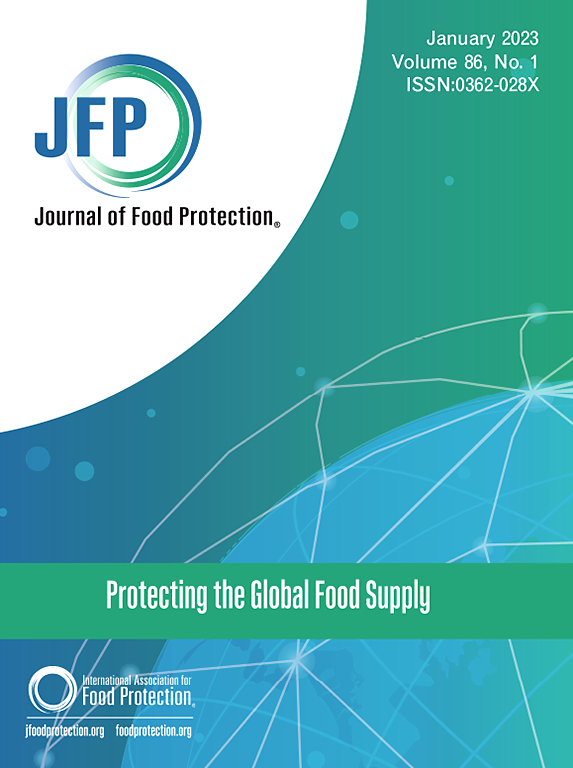Prevalence of Shiga Toxin-Producing Escherichia coli (STEC) and Risk Characterization Based on Virulence Genes in Retail Raw Ground Meat of Beef, Veal, and Lamb in Canada
IF 2.1
4区 农林科学
Q3 BIOTECHNOLOGY & APPLIED MICROBIOLOGY
引用次数: 0
Abstract
Shiga toxin-producing Escherichia coli (STEC) are potentially pathogenic E. coli that may cause mild to severe gastrointestinal illnesses. STEC-contaminated foods of animal origin have been the most frequently implicated sources of foodborne outbreaks. A multiyear (2016 to 2021) targeted survey was conducted to investigate the prevalence of STEC in retail ground meats (beef, veal, and lamb). Samples were screened for the presence of Shiga toxin genes (stx) to identify presumptive samples, followed by culture and molecular confirmation of isolates to confirm the presence of stx genes and subsequent characterization by whole-genome-sequencing (WGS) for O serogroup and virulence genes (e.g., stx, eae, aggR). A total of 175 STEC strains were isolated from a total of 148 samples where the presence of viable STEC was confirmed out of 2,398 ground meat samples. This represented 1.2% (7/589 positive, 8 unique strains) of the beef samples, 4.7% (58/1,241 positive, 67 unique strains) of the veal samples, and 14.6% (83/568 positive, 100 unique strains) of the lamb samples. The intimin virulence gene, eae, was identified in the STEC strains of veal origin (9/67, 13.4%) only and were classified as belonging to risk level 1 (1/67), level 3 (2/67), and level 4 (6/67) according to the FAO/WHO risk categories. Risk level 2 STEC strains were of beef (2/8, 25.0%), veal (8/67, 11.9%), and lamb (1/100, 1.0%) origin. The majority of the STEC strains, 75.0% (6/8) of the beef, 67.2% (45/67) of the veal, and 94.0% (94/100) of the lamb STEC strains were classified as risk level 5 (lowest level) of the FAO/WHO risk categories. This study’s findings indicate that the current food safety control measures implemented for ground meats in Canada are effective at maintaining an acceptable level of possible contamination with STEC strains associated with severe clinical outcomes. Continued application of effective control measures and safe food handling practices by consumers will minimize the potential risk of foodborne infections from raw ground meats.
产志贺毒素大肠杆菌(STEC)在加拿大零售牛肉、小牛肉和羊肉中流行及基于毒力基因的风险特征
产志贺毒素大肠杆菌(STEC)是潜在致病性大肠杆菌,可引起轻度至重度胃肠道疾病。产大肠杆菌污染的动物源性食品是食源性疾病暴发最常见的来源。进行了一项为期多年(2016-2021)的目标调查,以调查零售碎肉(牛肉、小牛肉和羊肉)中产志贺毒素大肠杆菌的患病率。对样本进行志贺毒素基因(stx)的筛选,以确定推定样本,然后对分离物进行培养和分子确认,以确认stx基因的存在,随后通过全基因组测序(WGS)对O血清组和毒力基因(如stx、eae、aggR)进行鉴定。从总共148份样本中分离出175株产志贺毒素大肠杆菌,其中2398份碎肉样本中确认存在活产志贺毒素大肠杆菌。牛肉样品中有1.2%(7/589阳性,8个独特菌株),小牛肉样品中有4.7%(58/1241阳性,67个独特菌株),羊肉样品中有14.6%(83/568阳性,100个独特菌株)。内膜毒力基因eae仅在产自小牛肉的产大肠杆菌菌株中被鉴定出来(9/67,13.4%),根据FAO/WHO的风险分类,被分为1级(1/67)、3级(2/67)和4级(6/67)。2级产STEC菌株分别为牛肉(2/8,25.0%)、小牛肉(8/67,11.9%)和羊肉(1/100,1.0%)。大多数STEC菌株,75.0%(6/8)的牛肉、67.2%(45/67)的小牛肉和94.0%(94/100)的羔羊STEC菌株被归为FAO/WHO风险等级的最低风险等级5。这项研究的结果表明,加拿大目前对绞肉实施的食品安全控制措施有效地将与严重临床结果相关的产大肠杆菌菌株可能污染维持在可接受的水平。消费者继续采取有效的控制措施和安全的食品处理做法,将最大限度地减少从生绞肉中获得食源性感染的潜在风险。
本文章由计算机程序翻译,如有差异,请以英文原文为准。
求助全文
约1分钟内获得全文
求助全文
来源期刊

Journal of food protection
工程技术-生物工程与应用微生物
CiteScore
4.20
自引率
5.00%
发文量
296
审稿时长
2.5 months
期刊介绍:
The Journal of Food Protection® (JFP) is an international, monthly scientific journal in the English language published by the International Association for Food Protection (IAFP). JFP publishes research and review articles on all aspects of food protection and safety. Major emphases of JFP are placed on studies dealing with:
Tracking, detecting (including traditional, molecular, and real-time), inactivating, and controlling food-related hazards, including microorganisms (including antibiotic resistance), microbial (mycotoxins, seafood toxins) and non-microbial toxins (heavy metals, pesticides, veterinary drug residues, migrants from food packaging, and processing contaminants), allergens and pests (insects, rodents) in human food, pet food and animal feed throughout the food chain;
Microbiological food quality and traditional/novel methods to assay microbiological food quality;
Prevention of food-related hazards and food spoilage through food preservatives and thermal/non-thermal processes, including process validation;
Food fermentations and food-related probiotics;
Safe food handling practices during pre-harvest, harvest, post-harvest, distribution and consumption, including food safety education for retailers, foodservice, and consumers;
Risk assessments for food-related hazards;
Economic impact of food-related hazards, foodborne illness, food loss, food spoilage, and adulterated foods;
Food fraud, food authentication, food defense, and foodborne disease outbreak investigations.
 求助内容:
求助内容: 应助结果提醒方式:
应助结果提醒方式:


